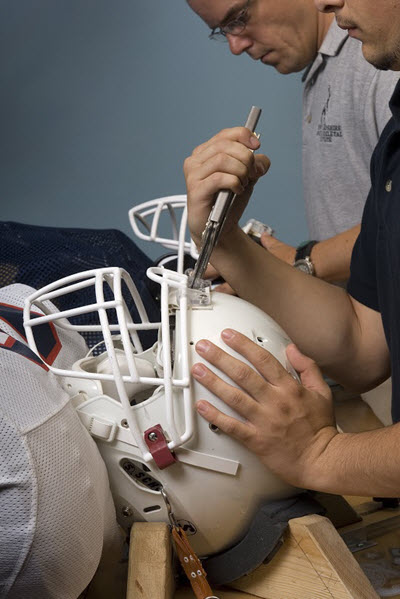- Home
- A Comparison of Emergency Facemask and Helmet Removal Effectiveness with Various Football Helmets and Facemask Attachment Systems
A Comparison of Emergency Facemask and Helmet Removal Effectiveness with Various Football Helmets and Facemask Attachment Systems
|
Al-Darraji SJ*, Swartz EE†, Bric JD*, Decoster LC*, Mihalik JP‡: †University of New Hampshire, Durham, NC, *New Hampshire Musculoskeletal Institute, Manchester, NH, ‡University of North Carolina, Chapel Hill, NC Context: The National Athletic Trainers’ Association recommends facemask removal (FMR) for emergency access to football players' airways with limited research comparing helmet removal (HR) and FMR. Recent changes in football helmet and facemask designs have implemented quick-release systems aimed at reducing FMR time. Comparing the relative efficacy of these two new systems to access the airway during FMR and HR tasks has not yet been investigated. Objective: To compare the amount of head movement, time to task completion, and perceived difficulty during FMR and HR across two different helmet designs. We hypothesized that FMR would result in less motion, time to task completion, and perceived difficulty than HR. Design: Quasi-experimental.
Setting: Research laboratory. Patients or Other Participants: Forty athletic trainers (ATs) free of physical pathology preventing them from completing the required tasks were recruited (males=21; females=19; age=33.7±11.2 yrs; mass=80.7±17.1 kg; height=173.1±9.2 cm; AT experience=10.6±10.4 yrs). Interventions: Independent variables consisted of helmet (Riddell Speed 360—RS360—or Schutt ION 4D—ION4D) and technique (facemask removal vs. helmet removal). After familiarization, paired participants conducted 4 successful trials in random order for each of four helmet-technique conditions (RS360-FMR; RS360-HR; ION4D-FMR; ION4D-HR). An eight-camera three-dimensional motion system and two, three-point segment marker sets (head and torso) were used to record head motion in a live model wearing properly fitted helmets and shoulder pads. Total time was recorded with a digital stopwatch. The difficulty for the task reported by the participant was recorded after each trial using a modified Borg CR-10 scale. Main Outcome Measures: Dependent variables included motion, total time and perceived difficulty. A 2x2 (helmet x technique) within-subjects repeated measures ANOVA was employed for each dependent variable (P= 0.05). Due to our participant pairing, our analyses were based on a sample of n=20. Results: We observed a significant helmet-by-technique interaction (F1,19=349.12; P=0.001); RS360-FMR took longer (31.22±7.89 s) than ION4D-FMR (20.45±3.57 s) or ION4D-HR (26.40±6.29). Helmet removal (sagittal: 14.88°±2.48°; frontal: 7.00°±1.14°; transverse: 7.00°±1.08°) resulted in greater motion than FMR (sagittal: 7.04°±1.80°; frontal: 4.73°±1.14°; transverse: 4.49°±0.89°) in all three planes of motion (sagittal: F1,19=187.27; frontal: F1,19=65.34; transverse: F1,19=68.36; P<0.001 for all). Our ATs reported equal task difficulty across both helmet designs and airway access techniques (F1,19=0.56; P=0.462). Conclusions: As hypothesized, FMR induced less motion than HR when accessing the airway, validating current clinical recommendations. Quick-release loop straps allow FMR to be completed in clinically acceptable times with less motion in all planes. Future research should continue to examine the effects of helmet designs on emergency airway access. This study was funded by the Eastern Athletic Trainers’ Association. |










